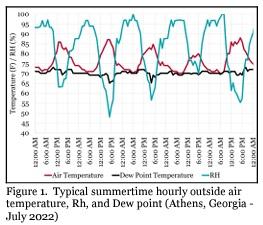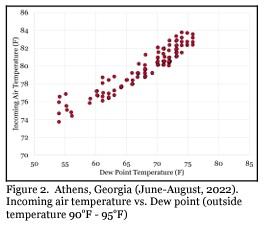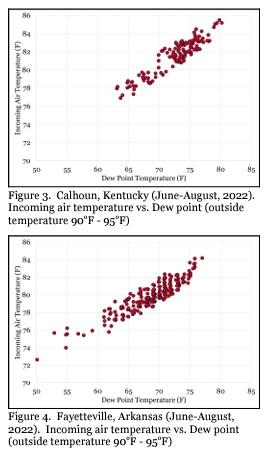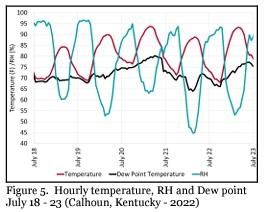The Importance of Monitoring Dew Point During Hot Weather
Published: December 5, 2023
By: Michael Czarick / Department of Poultry Science - University of Georgia.
When it comes to predicting the likelihood that birds will experience heat stress conditions on a given day, knowing outside relative humidity first thing in the morning is not particularly useful. Though air moisture levels have significant impact on bird comfort, relative humidity is constantly changing over the course of a day. In the morning relative humidity will tend to be between 80 and 100%. In the afternoon, as temperatures rise and the moistureholding ability of air increases, the relative humidity will decrease. How much the relative humidity will decrease on a given day, and therefore how likely growers will have problems keeping birds cool, is difficult to predict based on morning relative humidity. A far better predictor of the potential for heat stress conditions is the dew point temperature.

As air temperature decreases, its moisture holding capacity decreases and therefore the relative humidity increases. Dew point is the temperature to which the air needs to be cooled to increase the relative humidity to 100%. The lower the dew point temperature, the lower the amount of moisture in the air. The higher the dew point temperature, the higher the amount of moisture there is in the air. Dew point is a measure of the amount of moisture there is in the air independent of air temperature. Interestingly, though the outside relative humidity can change dramatically over a 24-hour period, the actual amount of moisture there is in the air doesn’t. Since the amount of moisture in the air is relative constant, the dew point temperature does not tend to change much over the course of a day (Figure 1) and as a result, it is a very good measure of air moisture levels that our birds will have to contend with on any given day.
What dew point temperatures should be of potential concern to poultry growers? A dew point of 65°F or lower is typically considered dry air and birds are very unlikely to become heat stressed. A 70°F dew point temperature indicates moderate air moisture levels. Market-age birds will likely experience some level of thermal discomfort, but with sufficient air speed and a properly operated evaporative cooling system, bird performance will not likely be affected. What growers need to be most concerned with is dew point temperatures of 75°F or higher. Dew point temperatures in this range indicate that there is a tremendous amount of moisture in the air and as a result, keeping market-age birds comfortable will be extremely difficult.


Figures 2, 3 and 4. illustrate how dew point temperature affects the cooling produced by a pad system when outside air temperatures are between 90°F and 95°F. Though the three locations; Athens, Georgia Calhoun, Kentucky and Fayetteville, Arkansas are far from one another, they exhibit a very similar relationship between pad cooling and dew point temperature. When dew point temperatures were in the sixties, incoming air temperatures were in the seventies and it would have been be relatively easy for most growers to keep market-age birds comfortable. When dew point increased into the low seventies, incoming air temperatures would have tended to be in the high seventies to low eighties. Keeping birds cool would have been more of a challenge but provided a house was capable of generating air speeds of 600 ft/min or more and the birds were evenly distributed, performance should have been minimally affected. But when dew point temperatures climbed above 75°F, incoming air temperature would have been increased to the low to much moisture in the air, the incoming relative humidity would have likely been near 90%, making it very difficult for the birds to cool themselves through panting.

Figure 5 illustrates how the dew point temperature can change over time as weather fronts bring moisture into and out of an area. Between July 18 and July 20 the daytime high increased 10°F. But of equal if not greater concern was the dew point temperature increased 10°F as well. Peak incoming air temperature for a typical house on the 19th would have been 80°F with a RH of 85%. Twenty four hours later the peak incoming air temperature would have increased to 86°F with a RH of 90%! Luckily, the next day the moisture moved out of the area and the dew point dropped below 70°F. But it is important to note that just the single day of dew point temperatures around 80°F resulted in the loss of thousands of birds in the area. As you might expect, the losses tended to be greatest in those houses with less-than-ideal air velocities.
Though we don’t have any control over the moisture content of air outside poultry houses, having an accurate measure of what it will be on any given and/or the next few days can warn a grower of potentially challenging conditions to come. All a grower needs to do is Google “current dew point” or “tomorrow’s dew point.” If it is going to be 75°F or higher, they need to prepare for the worst, especially if they have market-age birds. Fan/pad condition should be checked along with tunnel fan and pad settings, migration fences, circuit breaker temperatures, water filters, etc., all of which can affect their ability to keep their birds comfortable under the upcoming challenging conditions.
This article was originally published in Poultry Housing Tips, Volume 35, Number 7, 2023. University of Georgia, College of Agricultural and Environmental Sciences Cooperative Extension (https://www.poultryventilation.com/).
Related topics:
Related Questions
What is a better predictor of the potential for heat stress conditions in birds?
A far better predictor of the potential for heat stress conditions is the dew point temperature.
What dew point temperatures should poultry growers be concerned about?
What growers need to be most concerned with is dew point temperatures of 75°F or higher.
How does the increase in dew point temperature affect bird loss in poultry houses?
It is important to note that just the single day of dew point temperatures around 80°F resulted in the loss of thousands of birds in the area.
Authors:
University of Georgia
Recommend
Comment
Share

Would you like to discuss another topic? Create a new post to engage with experts in the community.








.jpg&w=3840&q=75)